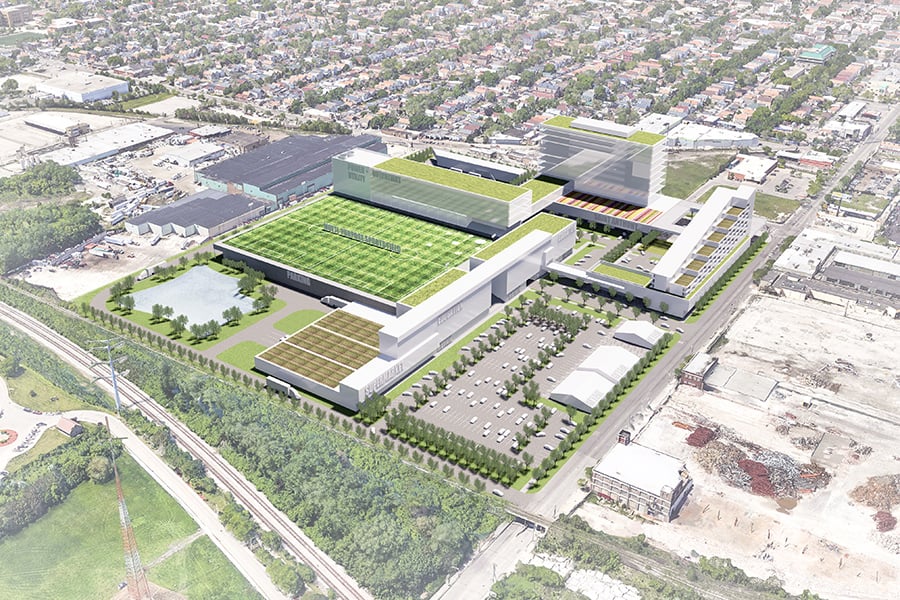
May 22, 2019
On Chicago’s South Side, a Bold Mixed-Use Healthcare Project Aims to Be a Community Anchor and Public Health Salve
The proposed design of the Focal Point Community Campus for the southwest side of Chicago puts health care at the center of a holistic approach to living. Quite literally, in fact. Conceived by HDR, the 33-acre mixed-use urban development is anchored by a hospital; augmenting this hub are education spaces, apartments, and even small-business incubators.The […]

The proposed design of the Focal Point Community Campus for the southwest side of Chicago puts health care at the center of a holistic approach to living. Quite literally, in fact. Conceived by HDR, the 33-acre mixed-use urban development is anchored by a hospital; augmenting this hub are education spaces, apartments, and even small-business incubators.
The project’s planners feel that the unorthodox development could be transformative for the surrounding underserved Little Village neighborhood. Situated along a heavily trafficked industrial corridor that has filled its air with particulate matter pollution, spiking asthma attacks, and emergency room visits, Little Village is one of the city’s poorest wards with some of its greatest public health needs. It’s a reminder that “where you live shapes your health,” as Metropolis digital content strategist Zachary Edelson put it in a recent Think Tank panel discussion at HDR’s Chicago office.
Shepherded by Chicago Southwest Development Corporation (CSDC), Focal Point Community Campus will incorporate a new facility for St. Anthony Hospital, a community pillar for 120 years. The plan’s rectilinear volumes—many topped with sports and cultivating fields—enclose a terraced amphitheater, which, in the renderings, make for an urban idyll of shopping and leisure. But the programmatic adjacencies prompted serious questions among the project stakeholders. “How do medical and retail work together so that one doesn’t turn their back on the other?” asked Tom Trenolone, a design director at HDR. Retail consultants want to keep their wares and showrooms away from the messy and often unpleasant reality of medical care. Yet, any strict segregation would be antithetical to Focal Point’s concept of community.

Focal Point “needs to be a place of gathering” and not just for newcomers, said CSDC president Guy Medaglia. The project is to be organized as a non-profit, with earnings funneled into a charitable foundation that disburses money to tenants and community partners. To further blunt gentrification and displacement, the CDSC is also working with local aldermen to establish a property-tax freeze in the area.
Medaglia is an oddity in the corporate world. He relayed aspects of his own upbringing in public housing and the “gang ink” he acquired throughout, but credits these past experiences with bolstering his own community engagement efforts. “That still doesn’t give you credibility,” he says. “That allows you in the door, and allows you to talk to people. And then you have to start really listening—through a lot of anger, some fear, a lot of disbelief. But you have to keep coming back. As long as I’ve got a breath, I’m going to fight for this community. From a capitalist perspective, people think I’ve lost my mind.”

In his time working in Chicago, Medalgia has seen more market-friendly, less programmatically ambitious deals happen much faster, with more public sector support. It’s been a long gestation for Focal Point, stretching back nearly a decade, with years given over to land acquisition alone. Just a day before the HDR panel, developer Sterling Bay’s Lincoln Yards, another Chicago mega-mixed-use development, was given key city council approval that will provide it with $1.6 billion in public subsidies to build new towers, parks, and shops in an already affluent neighborhood. Meanwhile, Little Village’s asthma rates soar.
“If you’ve got a billion bucks and a big name as a developer, you’ll get anything through city hall,” says Medaglia. It’s a mismatch between the market’s preferences and the public sector’s privations that will determine the health of Chicagoans.
You may also enjoy “The Refreshingly Simple and Deceptively Complex Architecture of SO-IL.”
Would you like to comment on this article? Send your thoughts to: [email protected]





